Family
Family Stories
Alexander Gemmell, benefactor
By Kay McMeekin and Bobby Grierson
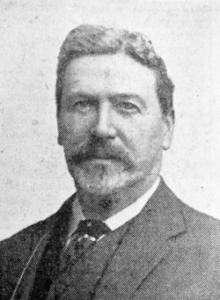 Alexander Gemmell was born in 1850 when his parents were living at The Green in Cumnock. This is now the area of the staff car park behind the Tanyard Medical Practice and directly behind the Box Church at the Dub.
Alexander Gemmell was born in 1850 when his parents were living at The Green in Cumnock. This is now the area of the staff car park behind the Tanyard Medical Practice and directly behind the Box Church at the Dub.
 His father John was a Stonecutter Quarryman who married Elizabeth Andrew in Cumnock in 1834. They had 8 children – 3 girls and 5 boys with Alexander being the youngest son. His mother, father and some siblings are buried in Cumnock old cemetery on Barrhill Road.
His father John was a Stonecutter Quarryman who married Elizabeth Andrew in Cumnock in 1834. They had 8 children – 3 girls and 5 boys with Alexander being the youngest son. His mother, father and some siblings are buried in Cumnock old cemetery on Barrhill Road.
 Alexander married Margaret Murdoch in 1873 at Crossriggs Cottage in Cumnock which is now Crossriggs Veterinary practice. They had six children – 3 boys and 3 girls.
Alexander married Margaret Murdoch in 1873 at Crossriggs Cottage in Cumnock which is now Crossriggs Veterinary practice. They had six children – 3 boys and 3 girls.
Alexander started his working life as a bank accountant with the Royal Bank of Scotland, Glaisnock Street in Cumnock. Around 1877 he moved to Keighley, Yorkshire where he was appointed branch manager of Bradford Old Bank. After a succession of mergers and further appointments the bank became United Counties which was then acquired by Barclay and Co Ltd in 1916 when Alexander was appointed branch manager of the Bradford group.
In 1916 Cumnock celebrated the 50th anniversary of Cumnock becoming a Police Burgh in 1886. To mark this Alexander came back to Cumnock and presented the gold chain and badge of office to the Provost James Richmond in his third term of office. The chain is 42 inches long and made of enamel and 15ct gold. 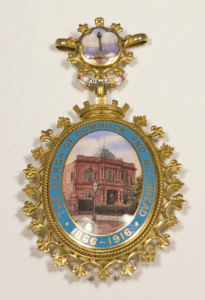
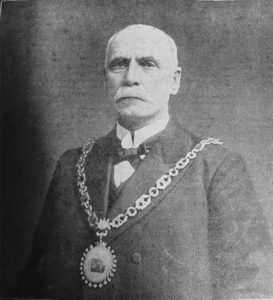
Provost James Richmond
Post ww1 he provided the Cumnock Parish medal made of silver and enamel. They were individually inscribed with the soldiers name and with in grateful remembrance or for services and presented to the soldiers or their families at the welcome Home Dance in Cumnock Town Hall in 1919
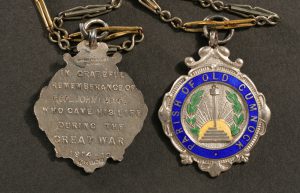
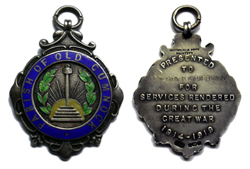
Alexander Gemmell died on 13 January 1923 in Bradford, Yorkshire, at the age of 73 and his will reveals he had effects of £20,552.
In 1925 Cumnock Town Council completed a scheme of houses to the south of the town hall and one of the streets, Gemmell Avenue was named in Alexander’s honour.
James Neil 1861- 1950
By Kay McMeekin
 James Neil was born on 11th August 1861 in Lugar and was Provost of Cumnock from 1928-1931. He also served as a Town Councillor from 1907 until 1936. He was the son of John Neil and Mary McGowan. This information is on his marriage certificate but it implies that the parents weren’t married. Usually it would say son of John Neil and Mary Neil maiden name McGowan but it just says John Neil and Mary McGowan.
James Neil was born on 11th August 1861 in Lugar and was Provost of Cumnock from 1928-1931. He also served as a Town Councillor from 1907 until 1936. He was the son of John Neil and Mary McGowan. This information is on his marriage certificate but it implies that the parents weren’t married. Usually it would say son of John Neil and Mary Neil maiden name McGowan but it just says John Neil and Mary McGowan.
So who’s the daddy?
I got his birth certificate to check this up. He was illegitimate but his father John, an iron miner of Lugar, had signed the birth certificate and Mary’s mother Hannah had actually been the informant – I like to imagine Hannah frog-marching John to the registrar’s office. The address for the birth was 103 Lugar. In the 1861 census the McGowans are recorded as living at 103 Peesweep Row and John Neil an iron miner is at 104 Peesweep Row – the boy next door. He was born in Prestwick in 1840 to James Neil and Helen Martin. John Neil married Agnes Cuming Bryce in October 1861 (a few months after the birth of James) and they left pretty soon after this for Australia. Circumstantial but persuasive!
James was married twice. His first wife Elizabeth Hyslop died young after the birth of daughter Agnes and he married again to Elizabeth Kerr. He was an insurance agent in 1891 and a commercial traveller in boots and shoes in 1911 living at 13 Lugar Street. He lost 2 sons in the Great War, more HERE. His other son John emigrated to the USA in 1926. He had daughters Agnes, Maggie and Bessie.
James made a proposal in 1925 to remove the Mercat Cross from the Square but this had to be dropped after a public outcry.

Mercat Cross
He was also instrumental in proposing the building of the first Council Houses in Cumnock in 1912 at John Baird Street which were occupied in March 1915. James was a contemporary of Keir Hardie and during this time converted to socialism.
James on the Cumnock Connections family tree
James Lennox 1851-1920 Cumnock-born Fleet st journalist
By Kay McMeekin
James Lennox was born in 1851 In Cumnock the son of James Lennox a blacksmith at Hillside and his wife Mary Mearns. He was apprentice printer with Duncan Ballantine of Glaisnock Street Cumnock.
By the time of his 1874 marriage to Jessie White he was a news reporter living in Cupar, Fife. In the 1881 census the couple are living in Greenock and he is working as a news reporter. In 1884 he was appointed to sub-editor and London correspondent of the Scotsman. He was treated to a dinner in the Imperial Hotel in Edinburgh by his Scotsman colleagues before leaving for London. In 1901 He and Jessie were visiting in Herne Bay, Kent. In 1911 they were in Herne Hill in Surrey. He was still described as a journalist & sub-editor.
They had one child who had died. James died at the same address “Cumnock” 3 Ferndene Road, Herne Hill Surrey on the 13th October 1920.
James Lennox on the Cumnock Connections tree
As a further note the Ballantines seemed to have been successful in promoting all their apprentices as can be seen by the photograph below. Standing left to right – Mr William Goldie who became associated editorially with the Sunday Mail, Mr Charles Gibb foreman and retired owner of his own printing business in Lugar Street, Cumnock, Mr James P Ballantine owner, Miss Jessie Ballantine and the printing apprentice of that day Mr Sam McMillan who later became editor of the Lennox Herald in Dumbarton.
James Thomson 1854-1876 Cumnock theologian
By Kay McMeekin
James Thomson was born in Cumnock in 1845 to weaver and woollen manufacturer William Thomson and his wife Elizabeth Dargavil. They were living at Townfoot, Cumnock in 1851.

James Thomson
He gained a Clark Scholarship to study at the University of Glasgow, Scotland in 1864. He took classes in Latin, Logic, Ethics, Greek, Mathematics, Physics, Hebrew, Divinity, Ecclesiastical History, and Biblical Criticism.
 He graduated with an MA in 1874. In 1875 he was awarded the Rae Wilson Gold Medal for the best essay on The Christology of the Synoptic Gospels – He went on to study theology in Germany but died in Badenweiler of consumption in 1876 aged only 31. The James Thomson Philosophical Entrance Bursary was founded in 1878 on the proceeds of a sum of £300. The bursary still continues today.
He graduated with an MA in 1874. In 1875 he was awarded the Rae Wilson Gold Medal for the best essay on The Christology of the Synoptic Gospels – He went on to study theology in Germany but died in Badenweiler of consumption in 1876 aged only 31. The James Thomson Philosophical Entrance Bursary was founded in 1878 on the proceeds of a sum of £300. The bursary still continues today.
His letters from Germany are in the University Archive. He is remembered on the family headstone in Cumnock old cemetery on the Barrhill Road.
James Thomson on Cumnock Connections tree
Esther McWhinnie - a tale of loss and separation
By Kay McMeekin
Esther McWhinnie (various spellings: Mawhinney, Mahoney) was born about 1858 in County Derry, Ireland. She married Thomas Marrs at Castledawson in Derry in 1877. Thomas Marrs may have been a cousin as Esther’s mother was Mary Marrs. The couple moved to Cumnock, Ayrshire, Scotland where there were already some Marrs family members. Thomas was a coal miner and the couple had 4 children Mary, John, Esther & Thomas in Cumnock before moving to Cowdenbeath in Fife where William was born in 1887.
Tragedy struck in 1889. Thomas was working as a brusher in Little Raith mine in Lochgelly, Fife when he was killed by a fall of stones on April 23rd 1889. Esther must have been pregnant at the time as she returned to Cumnock to have Daniel Marrs who was born on the 3rd June 1889 about 6 weeks after his father died.
Things must have been desperate. Widowed Esther aged 28 had 6 children ranging from a newborn to a 10 year old. However less than 2 years later in the 1891 census she is living in Riccarton near Kilmarnock with a younger man George Phillips 23 a bricklayer labourer and children: Mary Mars 12, William Mars 4, Daniel Mars 2.
Only three of the six children are present. Did the others die? Are they with other relatives? I still can’t locate them in 1891 but they did not die.
In 1892 Esther marries the aforementioned George Phillips. On the marriage certificate she states she is a lodging house keeper in Elbow Lane, Cumnock. This sounds quite grand but she may be embellishing it for the certificate and was probably an employee. George and Esther have two children together, a son George about 1892 and Matilda in 1894
It seems that Esther put 4 of her children into the care of Quarriers. Only the eldest Mary stayed. Perhaps she was old enough to earn her keep. In 1901 John was the adopted child of the Browns in New Cumnock. Adoption was an informal arrangement and there will be no documentation. Esther, Thomas, William and Daniel were with Quarriers and were shipped out to Canada as part of the ‘home children’ programme. I can only think she hoped they would have a better life. Some of these home children, it seems, had hard lives in Canada working as free labour on farms.
Esther age 9 went to Canada on the Sarmatia in 1892. Thomas went to Canada age 9 in 1895 on the Siberian. William 8 and Daniel 7 went out together in 1895 on the Sarmatia. It is hard to know the motivation and easy to judge. Were the missing children already in care in 1891? Did Esther keep in touch with her children in Canada? She was illiterate but the children would have received education at Quarriers. Did she ever see them again? (see below)
Eldest daughter Mary married William Davidson in 1897 and stayed the rest of her life in Cumnock. John who was in New Cumnock married there and went to Canada after he married in 1909. Perhaps he had been in touch with his siblings there. By 1901 Esther and George are in Ayr Road, Cumnock with their 2 children and 2 lodgers. In 1901 census of Canada William 16 and sister Essie (Esther) 14 are adopted at a farm at Lanark, Ontario. In 1907 Essie married John McCartney in Fernie, British Columbia. In 1911 George and Esther are at 23 – 25 Elbow Lane – lodging house (the same one as in 1892?) George, Esther, their children and 15 lodgers. In 1911 census William is also back in Cumnock lodging with sister Mary and her husband William Davidson also in Elbow Lane at no 44.
 Then came the Great War – Thomas and Daniel enlisted with the Canadian Forces. Daniel, single and a farmer, gave his mother as his next of kin. Thomas, single and a labourer and also gave his mother as next of kin. This certainly sounds as if they kept in touch with Esther.
Then came the Great War – Thomas and Daniel enlisted with the Canadian Forces. Daniel, single and a farmer, gave his mother as his next of kin. Thomas, single and a labourer and also gave his mother as next of kin. This certainly sounds as if they kept in touch with Esther.
Daniel was awarded the Distinguished Conduct Medal in February 1917 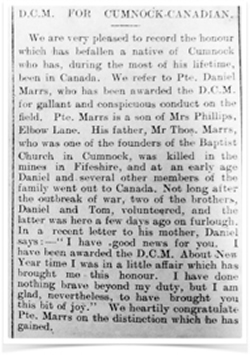 and was reported in the Cumnock Chronicle. It seemed that Tom visited his mother while on leave. However Daniel was killed in March 1917. Children Tom, John and Esther died in British Columbia, Canada. Mother Esther lived in Cumnock until her death in 1935.
and was reported in the Cumnock Chronicle. It seemed that Tom visited his mother while on leave. However Daniel was killed in March 1917. Children Tom, John and Esther died in British Columbia, Canada. Mother Esther lived in Cumnock until her death in 1935.
Phillips family - life in Skares between the wars
By May Williams (age 94)
I was born Mary Phillips 2nd daughter of Sam and Mary Phillips, née Shirkie, on 7th March 1922, 82 Skares Row, in the village of Skares near Cumnock in Ayrshire, Scotland.
 My father was a coal miner in Whitehill Pit, where he worked for 50 years. My mother was a hard working lady. She bore 10 children and worked on the farms all her working life. As my dad did not have big wages, mother did people’s washing and worked in the fields every summer. They were a great pair and very, very happy. Her sister was the farmer’s wife at Rottenrow Farm, between Skares and Ochiltree. Father was our shoe repairer and solderer. He was a first aid man at the pit, also doctor at home. He was very strict with us, but a very good father. He taught us to dance and sing.
My father was a coal miner in Whitehill Pit, where he worked for 50 years. My mother was a hard working lady. She bore 10 children and worked on the farms all her working life. As my dad did not have big wages, mother did people’s washing and worked in the fields every summer. They were a great pair and very, very happy. Her sister was the farmer’s wife at Rottenrow Farm, between Skares and Ochiltree. Father was our shoe repairer and solderer. He was a first aid man at the pit, also doctor at home. He was very strict with us, but a very good father. He taught us to dance and sing.
Mother taught us to cook, wash and sew and even taught us to paperhang and paint. We were very poor but very happy. Our meals all came from the land. Dad had a vegetable garden and homing pigeons. He caught rabbits and hares and mother made the loveliest soups and stews. We ate lots of trout from the streams and the fishmonger came round every week with herrings and whiteys, so we had fish twice a week as well. We got milk and eggs from the farms.
 I had four sisters and five brothers. And we all attended the village school, Skares School, and then at 11 years old we went on to Garrallan School and had to walk a mile and a half to this school. Hail, rain or snow we had to hoof it to the school. Sometimes we were snowed in and could not get there for a week or more in the wild winter.
I had four sisters and five brothers. And we all attended the village school, Skares School, and then at 11 years old we went on to Garrallan School and had to walk a mile and a half to this school. Hail, rain or snow we had to hoof it to the school. Sometimes we were snowed in and could not get there for a week or more in the wild winter.
We were all very healthy, but poorly dressed. We only got new clothes once a year. Our grandmother knitted and sewed to help clothe us. I wore all my sister’s hand me downs, even her boots which pinched my toes, hence my bunions today.
We had lots of friends, pals we called them, as mostly everyone in the village had from 5 to 20 children. Most children went to Sunday school and the Band of Hope. We had a Gala Day once a year, when the farmer loaned the horse and cart to take us out to one of his fields, where we had sandwiches and cookies, with milk or tea. Then lots of fun with singing and dancing and games. Even the fathers and mothers had races and tug of war. It was real fun. If you won a race you got sixpence and everyone got a penny. I think the Mums and Dads paid into a kitty every week.
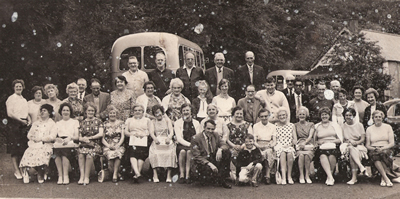
Skares bus trip
Our little village always had a football team, the Skares Bluebells. Most boys played football and men played quoits. There were always men relaxing in the wood playing cards. In winter it was curling on the loch. My dad didn’t play he was always walking. Himself and a few other dads used to have a string of children away walking for miles, especially on Sundays after church, while the mothers prepared dinner. We went hiking for miles and there was a cycling club if you could afford a bike.
There were not many cars about and buses ran every 20 minutes into our local towns, to Ayr and Cumnock. In Cumnock at the Auld Kirk there were buses to Kilmarnock, Glasgow, Ayr and Dumfries and all the local villages around about. Most of the time people walked as there wasn’t always enough money for fares. Skares was a little mining village. Most families only had two rooms and a scullery. Up until I was about 7 years old we had no water in the house. Our water came from pumps distributed between about 90 houses. Every 20 houses shared a pump; hence we had to carry the water in pails from the pump to our houses and the wash-houses, where everyone did their laundry. Then the washing was dried out in the green or in the wood, everyone sharing the wash houses and the clothes lines.
When the “Talkies” started at the picture house, as it was called then, we got once a year, that was on New Year’s Day. It was a wonderful day for us kids. When I was about 5 or 6 years old I took diphtheria as there was a big epidemic and quite a few people died. Most of the germs came from the dry lavatories which were all shared between two houses. Sometimes there were some not so hygienic neighbours, and mother always had to scrub the toilet seats before us children were allowed to use them. Poor mother. However, by the time I was 8 years old we got new drainage put in to the houses and running water laid on. Also, water lavatories put in but we still had to share. By this time we were all growing up and my sister and I were at work. We worked on the farms at first, having left school at thirteen.
 I worked at Auchlin and then Creoch. We also slept on the farms so things were a bit easier for mother at home. My eldest sister worked at farms for 4 years and I did 7 years. Then the war was on and I moved away from my hometown to Annan to work for the war effort away from the farms and into a hostel, working in a canteen for munitions workers. So from the age of thirteen until I was 24 I only went home for holidays. It was great in the hostel. We lived in and everyone worked and played hard. I was able to send some money home to help out with the younger brothers and sisters. My sister joined the ATS as an ambulance driver. She married a Canadian and went to live in Canada after the war ended.
I worked at Auchlin and then Creoch. We also slept on the farms so things were a bit easier for mother at home. My eldest sister worked at farms for 4 years and I did 7 years. Then the war was on and I moved away from my hometown to Annan to work for the war effort away from the farms and into a hostel, working in a canteen for munitions workers. So from the age of thirteen until I was 24 I only went home for holidays. It was great in the hostel. We lived in and everyone worked and played hard. I was able to send some money home to help out with the younger brothers and sisters. My sister joined the ATS as an ambulance driver. She married a Canadian and went to live in Canada after the war ended.
After the war, about 1949, my parents and family moved into a new house, with all mod cons, in Craigens Road, Netherthird.
With thanks to May’s daughter Mary Restarick.
Blackwoods in Chile
By Robert Watson
Thomas Blackwood, his wife Elizabeth Crawford and their two year old daughter joined 30 other families to travel from Kilmarnock, in August 1853, to London. They boarded the ship The Colinda bound for Canada but left the ship in Chile where Thomas was recruited to work in the coal mines in Lota. Their son Hugh Blackwood was born in Lota in 1856 and was sent back to Ayrshire to be educated. Initially returning to Dalmellington, Ayrshire to stay with his grandmother Catherine Blackwood nee Campbell he eventually settled in Cumnock and raised a large family. He died in 1929 and is buried in the Glaisnock Street cemetery in Cumnock.
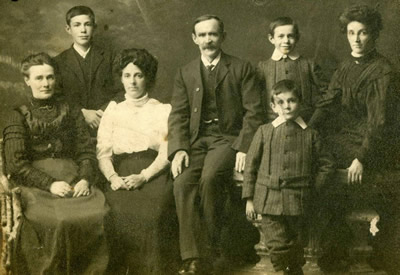
Hugh Blackwood’s family
Captain Mills challenged his surgeon to a duel with pistols across the table, terrorised the passengers and laid charges of Mutiny and Piratical acts against the passengers and crew.
Following the deaths of children and the harsh conditions rounding Cape Horn the passengers and crew prevailed upon Captain Mills to put ashore in Chile where the disputes could be settled by the British and Norwegian consuls there.
According to the later report made by James Douglas, Governor of Victoria, British Columbia, the Colinda arrived initially in Chile at the port of Valdivia where Captain Mills applied to the Admiral on station for an inquiry into the behaviour of the passengers. The Colinda was taken to Valparaiso, and the passengers were there tried, before a naval court, for “mutinous and piratical conduct” at the suit of Captain Mills, and acquitted.
The ship’s surgeon Dr Henry Coleman gave evidence in support of the passengers and against Captain Mills.
The passengers almost to a man, refused to proceed on the voyage under the command of Captain Mills, and left the Colinda at Valparaiso, with the exception of seventeen; who continued to Canada but who mostly deserted the ship on arrival in Canada and fled to the United States.
While Hugh was back in Scotland other Blackwoods stayed on in Chile and married locals. You can read more about the Blackwoods on Robert’s blog HERE and on the Hugh Blackwood tree HERE.
The photo below is Hugh’s brother William aka Guillermo and his family c. 1905.
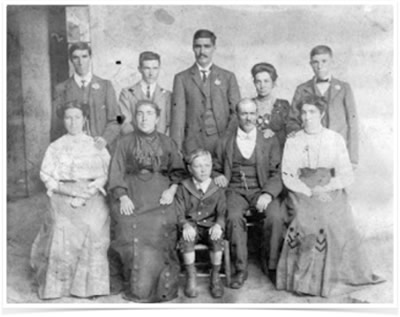
Guillermo’s family
How I got hooked on family history by Kay McMeekin
By Kay McMeekin, chair of CHG and genealogist
I have a confession. I wasn’t born in Cumnock and I have never lived in Cumnock. It’s the McMeekins who have been in Cumnock since the 1851 census. My own name is Rolinson.
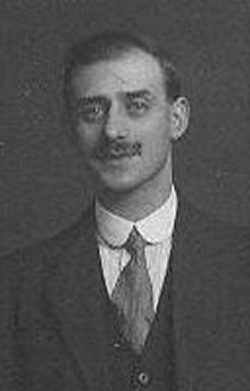
 My grandfather James Ball Rolinson was a miner in the 1901 census but by 1906 he was driving one of the first buses in Edinburgh. In 1913 he was a chauffeur in Dollar. He worked for Anderson’s in Newton Mearns and also Rosslea Motors and in 1935 he opened his own garage business in Glasgow’s Gallowgate. My father and his brothers also joined the firm which operated until about 1980. All I knew about my grandfather’s origins was that he was born in Yorkshire that his mother was Emma and that they lived in Calderbank in Lanarkshire.
My grandfather James Ball Rolinson was a miner in the 1901 census but by 1906 he was driving one of the first buses in Edinburgh. In 1913 he was a chauffeur in Dollar. He worked for Anderson’s in Newton Mearns and also Rosslea Motors and in 1935 he opened his own garage business in Glasgow’s Gallowgate. My father and his brothers also joined the firm which operated until about 1980. All I knew about my grandfather’s origins was that he was born in Yorkshire that his mother was Emma and that they lived in Calderbank in Lanarkshire.
I worked backwards through censuses. Good gracious, in the 1881 census they are in Cumnock in the same miners’ row that my husband’s family lived in, Glengyron Row. What an amazing coincidence! I think that is what got me hooked on genealogy. Three generations of Rolinsons are there in Glengyron Row in 2 houses next door to each other. My great grandparents James Rolinson and Emma Ball and 3 daughters (my grandfather is still to come), the great great grandparents John Rolinson and Jane (Holmes), their son Matthew Rolinson and a lodger. Next door is son Emmanuel Rolinson and wife Hannah (Jones) 4 sons and 3 adult male lodgers. So 8 living in one house and 9 in the other. These houses had 2 rooms! All of them are born in England except for 2 of the children who were born in Cumnock, the wonderfully named Delilah Rolinson 1880 my great aunt and John in 1874 Emmanuel’s son. They are all from Walsall or Tipton in Staffordshire. The lodgers and the neighbours also turn out to be family members.
 In the previous census of 1871 they are in Cumnock too, at Kilnholm Place. I reckon Glengyron Row was built about 1872 to house the influx of miners, so it probably was the height of luxury, as it was at the time, and a way of attracting miners to the area. Although they are in Cumnock in these 2 censuses it seems they have gone back to England between the 1871 and 1881 censuses judging by the birthplaces of the children. I can only suppose they went where there was work. They were in Rotherham, Yorkshire in the 1880s where my papa was born. By the 1891 census they were in Lanarkshire as expected and there are still Rolinsons in Calderbank.
In the previous census of 1871 they are in Cumnock too, at Kilnholm Place. I reckon Glengyron Row was built about 1872 to house the influx of miners, so it probably was the height of luxury, as it was at the time, and a way of attracting miners to the area. Although they are in Cumnock in these 2 censuses it seems they have gone back to England between the 1871 and 1881 censuses judging by the birthplaces of the children. I can only suppose they went where there was work. They were in Rotherham, Yorkshire in the 1880s where my papa was born. By the 1891 census they were in Lanarkshire as expected and there are still Rolinsons in Calderbank.
Although my direct line is no longer in Cumnock, other relations the Yates, Prices and Joneses, stayed on in Cumnock, Auchinleck and Dalmellington. I had no idea I had any connection to Ayrshire where I have lived since 1973.
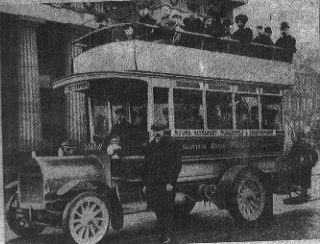
Jim at the wheel of bus in Edinburgh 1906

Ferguson or McLatchie in Australia
For almost 50 years I have searched for a John Robb Ferguson, b.1833 and son of a Robert Ferguson and possibly a Janet Robb – firstly, in Lanarkshire and also in Ayrshire – Old Cumnock – which holds a special place, as I will explain later. I started out searching Directories, Census and other Scottish records via ‘real’ mail to Libraries in Scotland. And also through searching available records held in Australian libraries. Then, when they became available, by winding my way through countless reels of Scottish Census records on film, which had been made available through the Society of Australian Genealogists. Then, in more recent years, with the advent of the internet and DNA matching, my brother Robert had his DNA tested via Ancestry.com. This led us, firstly, to confirm that ROBB was a family surname, as he had a strong match to at least two living individuals, who resided in the UK – and were descendants of John Robb and Janet Lindsay of Wiston, Lanarkshire. An email correspondence began, which may well have been our first contact with living UK relations for over 100 years!
Now one of that Robb family, a Katherine or Catherine Robb, was born Biggar, Lanarkshire and had married in Old Cumnock, 1827 to a Robert McLetchie (1799-1858), who was a ‘Snuff Box Maker’ (1841 Old Cumnock Census) and later ‘Store Labour’ (1851 Glasgow Cen.); ‘Joiner’ (Death cert. Glasgow, 1858), and ‘Grocer’s Storekeeper’ (1887 Death cert. for wife, Catherine). The children of this couple, who were all born in Old Cumnock, are shown in the ‘Trees’ of the ‘Cumnock Connections’ site. Unfortunately, baptismal records have not been located which would have been most helpful.
From an Australian newspaper – ‘Sydney Record’ of 24th February, 1844 –
Regarding ‘Snuff Box Makers’, I recently came across this advertisement which lists ‘Cumnock Snuff Boxes’ as having arrived in Sydney, 1844 via the ship ‘Camena’ from Leith and, among other items, lists ‘Thirteen dozen Cumnock snuff boxes, assorted patterns of the Clans…’
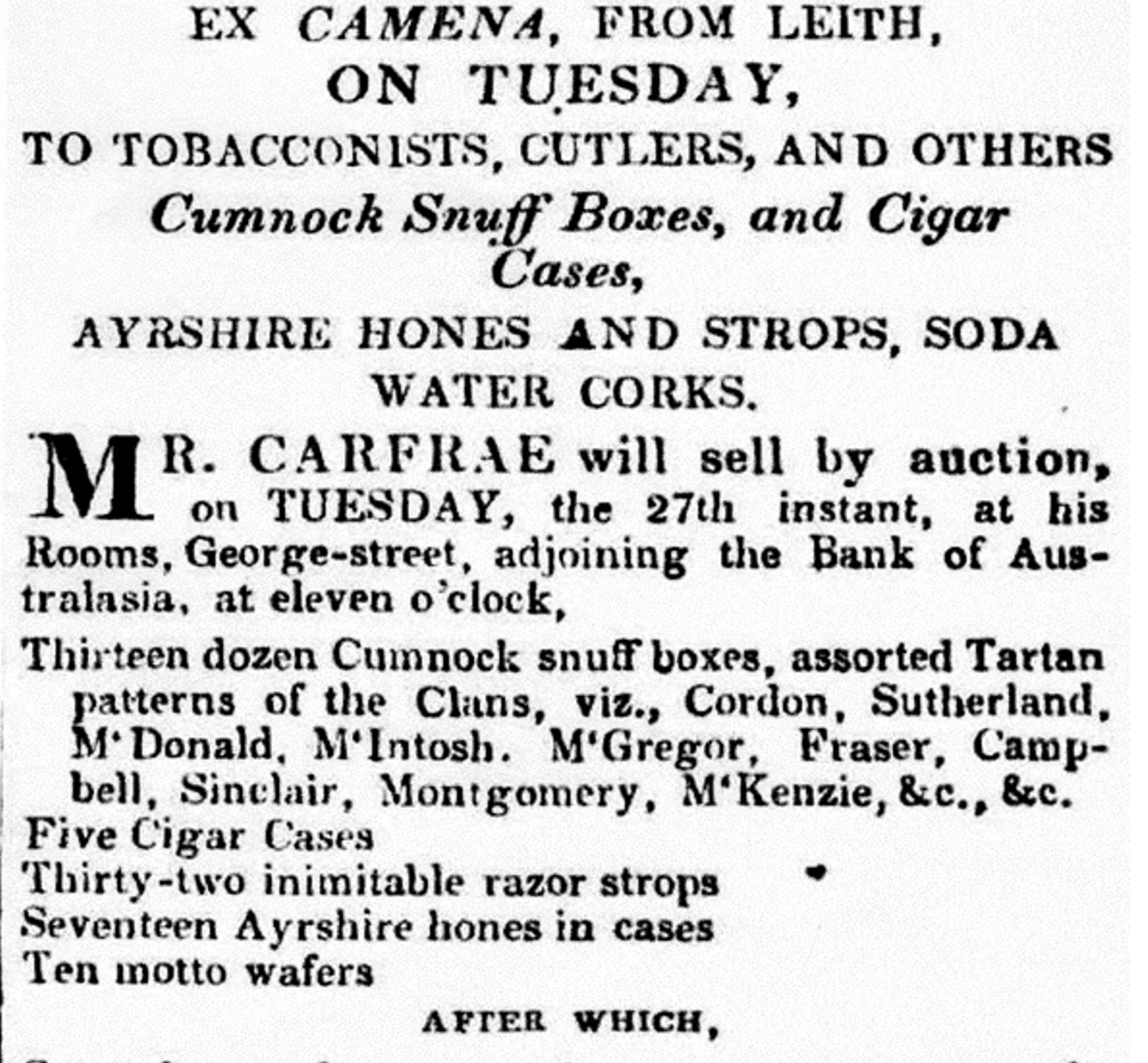
Sydney Record 1844
There must have been something special about ‘Cumnock’ Snuff boxes, as various articles affirm.
Back to my story: for a time, we had considered whether the Robb – Lindsay couple mentioned above, had a daughter named Janet. But of her, if she had existed, no record could be located. The ‘penny’ finally dropped in June, last year, as four known events coincided and which illustrate the value of Family stories.
# Ship wrecked: A family story was that ‘your Great Grandfather was shipwrecked’ when he attempted to migrate to Australia, during 1854. This was a major clue, but only one Aunt could tell me the name of this ship, the ‘Tayleur’. A Great Aunt told me that her Grandfather had brought her Father (JRF) home from the shipwreck (on its maiden voyage, from Liverpool) and that he, John Robb Ferguson (1833-1901), was ‘from Glasgow’.
Here is an extract from one Australian newspaper account of the wreck of the ‘Tayleur’:
Courier (Hobart, Tas. : Wednesday 3 May 1854, page 2
‘Almost as unaccountable as horrible is the loss of the Tayleur, with more than 370 souls, of which nearly 200 were women and children, three females, one adult and two girls only having been saved. The Tayleur left the Mersey (Liverpool) on Thursday, the 19th, January 1854 with a fair wind…’. Four days later, an eyewitness wrote from Dublin, that: “I then went up, but soon saw it was all over with the Tayleur; and in less than half an hour she was on shore. Then came a most heartrending-scene, men shouting and screeching for their wives and children; wives looking for their husbands, and children for their parents; some praying, some frantically wringing their hands. The vessel struck (off Lambay Island, Ireland on 21st Jan.) abaft the mizen mast, with the first or second crash knocking up her rudder, together with the wheel. Her stern part came close to the land, it being very deep water. Some then jumped off on the rocks; the second man struck his head against the rock, dashed the front in,- and fell back in the water a corpse, together with many others who made the same leap. At last a rope was thrown from the ship, by which many were saved, although not one out of three who made the attempt reached the land, most of them dropping into the sea, and of these there were only three or four who were saved.”
This account also provides the following information: ‘The surviving passengers of the John Tayleur will be sent on in the ‘Golden Era’ in March. This vessel is 3000 tons, and a beautiful clipper.’
# Passenger lists for these two ships show the names of a John McLetchie and also a John Ferguson (crew). This Ferguson was initially thought to be the ‘one’ I was looking for, but was sadly ruled out through subsequent investigations. John McLetchie was recorded on the ‘Tayleur’ list as being ‘lost’, but strangely had reappeared on the replacement ship. Two recent authors of books about the ‘Tayleur’ shipwreck note that errors and omissions had occurred in the various passenger lists available.
# Memorabilia: Postcards of Old Cumnock, dated to c1910. A Grt. Aunt had given me two old Postcards, with coloured scenes of Old Cumnock. Coincidentally, my parents had one very similar Postcard and this may well have been the reason why my Father had named his Cocker Spaniel breeding kennel, ‘Cumnock’.
# Doctor in the house?: Another family story was that ‘your Grt Grandfather had a brother who was a doctor’. I soon discovered that a brother of John McLetchie (b.1833 Old Cumnock), named Andrew (1836-1867), become a ‘Surgeon’ and had migrated to USA following his Father’s death in 1858. The ‘Glasgow Herald’ of 30 October, 1867. Pg. 5 has: Deaths. ‘At New York, on the 13th inst., Dr Andrew McLatchie, late surgeon of the 79th Highlanders, N.G.S.N.Y., aged 30 years.’ He was practising in Glasgow around 1858, and his name appears on his Father’s Death certificate of 1858, as the informant.
My Great Grandfather, John Robb Ferguson ( or McLetchie/McLatchie) married in Australia and was initially a gold miner; then a carpenter and ‘master builder’. He also had an inventive streak and made and had patented a number of items, such as a wooden washing machine, an improved butter churn, and a small paddle boat. He was a respected elder of the Presbyterian Church. Sadly, he did not make a journey back to Scotland and left few memories of his upbringing and family. Although, it was said that he ‘went looking’ for some relations who may have migrated to Australia.
Incidentally, there is little evidence of John McLetchie being in Australia after his arrival in 1854. This may be because he went to the goldfields, which were often distant from major towns, and/or changed his surname. A search of digitised newspapers revealed his name appeared in a listing of ‘Unclaimed letters’ held at Melbourne Post Office, during 1855.
It has been a long and elusive search. Any comments, suggestions and/or memories that relate to this man or his Scottish family, would be much appreciated.
Keith A. Ferguson,
11 January, 2022
Mail address: 33 Morna Point Rd., Anna Bay, NSW 2316, Australia.
Email: keithsandra81@outlook.com
If you feel that you would like to donate a money gift to CHG to help us continue our research into the people and places of Cumnock